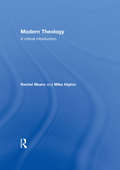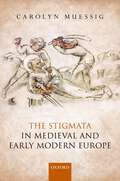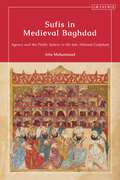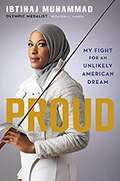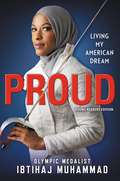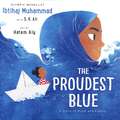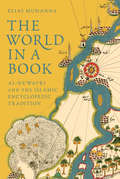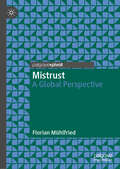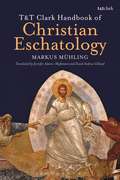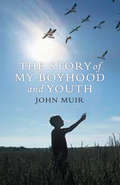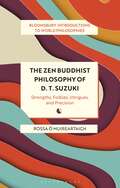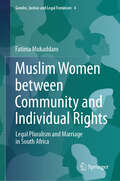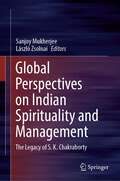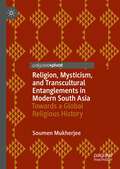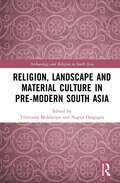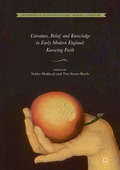- Table View
- List View
Modern Theology: A Critical Introduction
by Rachel Muers Mike HigtonThis book offers a fresh and up-to-date introduction to modern Christian theology. The ‘long nineteenth century’ saw enormous transformations of theology, and of thought about religion, that shaped the way both Christianity and ‘religion’ are understood today. Muers and Higton provide a lucid guide to the development of theology since 1789, giving students a critical understanding of their own ‘modern’ assumptions, of the origins of the debates and the fields of study in which they are involved, and of major modern thinkers. Modern Theology: introduces the context and work of a selection of major nineteenth-century thinkers who decisively affected the shape of modern theology presents key debates and issues that have their roots in the nineteenth century but are also central to the study of twentieth- and twenty-first-century theology includes exercises and study materials that explicitly focus on the development of core academic skills. This valuable resource also contains a glossary, timeline, annotated bibliographies and illustrations.
Modern Theology: A Critical Introduction (The\great Theologians Ser.)
by Rachel Muers Mike HigtonThis book offers a fresh and up-to-date introduction to modern Christian theology. The ‘long nineteenth century’ saw enormous transformations of theology, and of thought about religion, that shaped the way both Christianity and ‘religion’ are understood today. Muers and Higton provide a lucid guide to the development of theology since 1789, giving students a critical understanding of their own ‘modern’ assumptions, of the origins of the debates and the fields of study in which they are involved, and of major modern thinkers. Modern Theology: introduces the context and work of a selection of major nineteenth-century thinkers who decisively affected the shape of modern theology presents key debates and issues that have their roots in the nineteenth century but are also central to the study of twentieth- and twenty-first-century theology includes exercises and study materials that explicitly focus on the development of core academic skills. This valuable resource also contains a glossary, timeline, annotated bibliographies and illustrations.
The Stigmata in Medieval and Early Modern Europe
by Carolyn MuessigFrancis of Assisi's reported reception of the stigmata on Mount La Verna in 1224 is almost universally considered to be the first documented account of an individual miraculously and physically receiving the five wounds of Christ. The early thirteenth-century appearance of this miracle, however, is not as unexpected as it first seems. Interpretations of Galatians 6:17—I bear the marks of the Lord Jesus Christ in my body—had been circulating since the early Middle Ages in biblical commentaries. These works perceived those with the stigmata as metaphorical representations of martyrs bearing the marks of persecution in order to spread the teaching of Christ in the face of resistance. By the seventh century, the meaning of Galatians 6:17 had been appropriated by bishops and priests as a sign or mark of Christ that they received invisibly at their ordination. Priests and bishops came to be compared to soldiers of Christ, who bore the brand (stigmata) of God on their bodies, just like Roman soldiers who were branded with the name of their emperor. By the early twelfth century, crusaders were said to bear the actual marks of the passion in death and even sometimes as they entered into battle. The Stigmata in Late Medieval and Early Modern Europe traces the birth and evolution of religious stigmata and particularly of stigmatic theology, as understood through the ensemble of theological discussions and devotional practices. Carolyn Muessig assesses the role stigmatics played in medieval and early modern religious culture, and the way their contemporaries reacted to them. The period studied covers the dominant discourse of stigmatic theology: that is, from Peter Damian's eleventh-century theological writings to 1630 when the papacy officially recognised the authenticity of Catherine of Siena's stigmata.
The Stigmata in Medieval and Early Modern Europe
by Carolyn MuessigFrancis of Assisi's reported reception of the stigmata on Mount La Verna in 1224 is almost universally considered to be the first documented account of an individual miraculously and physically receiving the five wounds of Christ. The early thirteenth-century appearance of this miracle, however, is not as unexpected as it first seems. Interpretations of Galatians 6:17—I bear the marks of the Lord Jesus Christ in my body—had been circulating since the early Middle Ages in biblical commentaries. These works perceived those with the stigmata as metaphorical representations of martyrs bearing the marks of persecution in order to spread the teaching of Christ in the face of resistance. By the seventh century, the meaning of Galatians 6:17 had been appropriated by bishops and priests as a sign or mark of Christ that they received invisibly at their ordination. Priests and bishops came to be compared to soldiers of Christ, who bore the brand (stigmata) of God on their bodies, just like Roman soldiers who were branded with the name of their emperor. By the early twelfth century, crusaders were said to bear the actual marks of the passion in death and even sometimes as they entered into battle. The Stigmata in Late Medieval and Early Modern Europe traces the birth and evolution of religious stigmata and particularly of stigmatic theology, as understood through the ensemble of theological discussions and devotional practices. Carolyn Muessig assesses the role stigmatics played in medieval and early modern religious culture, and the way their contemporaries reacted to them. The period studied covers the dominant discourse of stigmatic theology: that is, from Peter Damian's eleventh-century theological writings to 1630 when the papacy officially recognised the authenticity of Catherine of Siena's stigmata.
Sufis in Medieval Baghdad: Agency and the Public Sphere in the Late Abbasid Caliphate
by Atta MuhammadThis book examines the political and social activities of Sufis in Baghdad in the period 1000-1258. It argues that Sufis played an important role in creating a public sphere that existed between ordinary subjects and the government. Drawing on Arabic sources and secondary literature, it explores the role of Sufis and their institutions including their ribats or lodge houses, from the use of Sufis as political ambassadors to their role in redistributing charity to the poor. The book reveals the role of Sufism in structuring a wide range of social and political arrangements in this period. It also reveals the role of ordinary, non-elite actors who, by taking part in Sufi-affiliated religious or professional associations, were able take part in public life in late-Abbasid Baghdad.
Sufis in Medieval Baghdad: Agency and the Public Sphere in the Late Abbasid Caliphate
by Atta MuhammadThis book examines the political and social activities of Sufis in Baghdad in the period 1000-1258. It argues that Sufis played an important role in creating a public sphere that existed between ordinary subjects and the government. Drawing on Arabic sources and secondary literature, it explores the role of Sufis and their institutions including their ribats or lodge houses, from the use of Sufis as political ambassadors to their role in redistributing charity to the poor. The book reveals the role of Sufism in structuring a wide range of social and political arrangements in this period. It also reveals the role of ordinary, non-elite actors who, by taking part in Sufi-affiliated religious or professional associations, were able take part in public life in late-Abbasid Baghdad.
Proud: My Fight for an Unlikely American Dream
by Ibtihaj MuhammadGrowing up in New Jersey as the only African American Muslim at school, Ibtihaj Muhammad always had to find her own way. When she discovered fencing, a sport traditionally reserved for the wealthy, she had to defy expectations and make a place for herself in a sport she grew to love. From winning state championships to three-time All-America selections at Duke University, Ibtihaj was poised for success, but the fencing community wasn't ready to welcome her with open arms just yet. As the only woman of color and the only religious minority on Team USA's saber fencing squad, Ibtihaj had to chart her own path to success and Olympic glory. Proud is a moving coming-of-age story from one of the nation's most influential athletes and illustrates how she rose above it all.
Proud (Young Readers Edition): Living My American Dream
by Ibtihaj MuhammadThe inspiring and critically acclaimed all-American story of faith, family, hard work, and perseverance by Olympic fencer, activist, New York Times bestselling author, and Time "100 Most Influential People" honoree Ibtihaj Muhammad At the 2016 Olympic Games, Ibtihaj Muhammad smashed barriers as the first American to compete wearing hijab, and she made history as the first Muslim American woman to win a medal. But before she was an Olympian, activist, and entrepreneur, Ibtihaj was a young outsider trying to find her place. Growing up in suburban New Jersey, Ibtihaj was often the only African American Muslim student in her class. When she discovered and fell in love with fencing, a sport most popular with affluent young white people, she stood out even more. Rivals and teammates often pointed out Ibtihaj's differences, telling her she would never succeed. Yet she powered on, rising above bigotry and other obstacles on the path to pursue her dream. Ibtihaj's inspiring journey from humble beginnings to the international stage is told in her own words and enhanced with helpful advice and never-before-published photographs. Proud is an all-American tale of faith, family, hard work, and self-reliance.
The Proudest Blue
by Ibtihaj Muhammad Hatem AlyIt’s Faizah’s first day of school, and her older sister Asiya’s first day of hijab – made of a beautiful blue fabric. But not everyone sees hijab as beautiful. In the face of hurtful, confusing words, will Faizah find new ways to be strong?
The World in a Book: Al-Nuwayri and the Islamic Encyclopedic Tradition
by Elias MuhannaShihab al-Din al-Nuwayri was a fourteenth-century Egyptian polymath and the author of one of the greatest encyclopedias of the medieval Islamic world—a thirty-one-volume work entitled The Ultimate Ambition in the Arts of Erudition. A storehouse of knowledge, this enormous book brought together materials on nearly every conceivable subject, from cosmology, zoology, and botany to philosophy, poetry, ethics, statecraft, and history. Composed in Cairo during the golden age of Islamic encyclopedic activity, the Ultimate Ambition was one of hundreds of large-scale compendia, literary anthologies, dictionaries, and chronicles produced at this time—an effort that was instrumental in organizing the archive of medieval Islamic thought.In the first study of this landmark work in a European language, Elias Muhanna explores its structure and contents, sources and influences, and reception and impact in the Islamic world and Europe. He sheds new light on the rise of encyclopedic literature in the learned cities of the Mamluk Empire and situates this intellectual movement alongside other encyclopedic traditions in the ancient, medieval, Renaissance, and Enlightenment periods. He also uncovers al-Nuwayri’s world: a scene of bustling colleges, imperial chanceries, crowded libraries, and religious politics.Based on award-winning scholarship, The World in a Book opens up new areas in the comparative study of encyclopedic production and the transmission of knowledge.
The World in a Book: Al-Nuwayri and the Islamic Encyclopedic Tradition
by Elias MuhannaShihab al-Din al-Nuwayri was a fourteenth-century Egyptian polymath and the author of one of the greatest encyclopedias of the medieval Islamic world—a thirty-one-volume work entitled The Ultimate Ambition in the Arts of Erudition. A storehouse of knowledge, this enormous book brought together materials on nearly every conceivable subject, from cosmology, zoology, and botany to philosophy, poetry, ethics, statecraft, and history. Composed in Cairo during the golden age of Islamic encyclopedic activity, the Ultimate Ambition was one of hundreds of large-scale compendia, literary anthologies, dictionaries, and chronicles produced at this time—an effort that was instrumental in organizing the archive of medieval Islamic thought.In the first study of this landmark work in a European language, Elias Muhanna explores its structure and contents, sources and influences, and reception and impact in the Islamic world and Europe. He sheds new light on the rise of encyclopedic literature in the learned cities of the Mamluk Empire and situates this intellectual movement alongside other encyclopedic traditions in the ancient, medieval, Renaissance, and Enlightenment periods. He also uncovers al-Nuwayri’s world: a scene of bustling colleges, imperial chanceries, crowded libraries, and religious politics.Based on award-winning scholarship, The World in a Book opens up new areas in the comparative study of encyclopedic production and the transmission of knowledge.
Mistrust: A Global Perspective
by Florian MühlfriedThis book examines the social practice of mistrust through the lens of social anthropology. In focusing on the citizens of the Caucasus, a region located at the crossroads of Europe and Asia, Mühlfried counters the postcolonial discourse that routinely treats these individuals, known for their mistrust of the state, as “others.” Combining ethnographic observations presenting mistrust as an observable reality with socio-political issues from a non-Western region, Mühlfried opens up a non-Eurocentric perspective on an underexplored social practice and a major counterpoint to the well-examined social phenomenon of “trust.” This perspective allows for a more profound understanding of pressing issues such as populist movements and post-truth politics.
T&T Clark Handbook of Christian Eschatology
by Dr Markus MühlingThis textbook offers a systematic introduction to eschatology. The first part introduces the historical approaches to eschatology. The second part concerns the reasons for eschatological statements in light of important aspects of the doctrine of God and Christ. The third part is devoted to different concepts of the relationship between eternity and time, space and infinitude as well as the question of what is good, true and beautiful. Using a thematic structure, the multiple different approaches and concepts of modern eschatology are clearly presented, and illuminated by the perspective of the classical teachings on the Last Things; which are ultimately brought together in a synthesis. This is an important contribution to a crucial part of the study of systematic theology.
T&T Clark Handbook of Christian Eschatology
by Markus MühlingThis textbook offers a systematic introduction to eschatology. The first part introduces the historical approaches to eschatology. The second part concerns the reasons for eschatological statements in light of important aspects of the doctrine of God and Christ. The third part is devoted to different concepts of the relationship between eternity and time, space and infinitude as well as the question of what is good, true and beautiful. Using a thematic structure, the multiple different approaches and concepts of modern eschatology are clearly presented, and illuminated by the perspective of the classical teachings on the Last Things; which are ultimately brought together in a synthesis. This is an important contribution to a crucial part of the study of systematic theology.
Story of My Boyhood and Youth (The\john Muir Library)
by John MuirIn this moving memoir of an unusual childhood, John Muir recalls his younger days in East Lothian with a startling clarity, depicting a wild boy whose quiet individuality and determination were already emerging. Born in mid nineteenth-century Scotland, Muir was eleven when his fanatically religious father took the family to build a new life in America's vast wilderness. Muir charts their pioneering years in Wisconsin, where his battles for survival powerfully anticipate the extraordinary career which was to follow. They reveal a free spirit who perceived bonds between man and nature that were subtle and far reaching for both.Relatively unknown in his native Scotland, John Muir is renowned in the United States as the father of conservation. A friend of presidents and founder of National Parks, Muir was inspired by a love and a vision of nature as remarkable today as it was last century.
The Zen Buddhist Philosophy of D. T. Suzuki: Strengths, Foibles, Intrigues, and Precision (Bloomsbury Introductions to World Philosophies)
by Rossa Ó MuireartaighD.T. Suzuki (1870-1966) reached global fame for his writings on Zen Buddhism. In this introduction to his theories of self, knowledge, and the world, Suzuki is presented as a Buddhist philosopher in his own right.Beginning with a biography of his life providing the historical context to his thought and discussing Suzuki's influences, chapters cover the Zen notion of the non-self and Suzuki's Zen view of consciousness, language, and religious truths. His ideas about philosophy and radical views on rationality and faith come to life in two new complete translations of The Place of Peace in our Heart (1894) and Science and Religion (1949), which helps us to understand why Suzuki's description of Zen attracted the attention of many leading intellectuals and helped it become a household name in the English-speaking world.Offering the first complete overview of Suzuki's approach, reputation, and legacy as a philosopher, this is for anyone interested in the philosophical relevance and development of Mahayana Buddhism today.
The Zen Buddhist Philosophy of D. T. Suzuki: Strengths, Foibles, Intrigues, and Precision (Bloomsbury Introductions to World Philosophies)
by Rossa Ó MuireartaighD.T. Suzuki (1870-1966) reached global fame for his writings on Zen Buddhism. In this introduction to his theories of self, knowledge, and the world, Suzuki is presented as a Buddhist philosopher in his own right.Beginning with a biography of his life providing the historical context to his thought and discussing Suzuki's influences, chapters cover the Zen notion of the non-self and Suzuki's Zen view of consciousness, language, and religious truths. His ideas about philosophy and radical views on rationality and faith come to life in two new complete translations of The Place of Peace in our Heart (1894) and Science and Religion (1949), which helps us to understand why Suzuki's description of Zen attracted the attention of many leading intellectuals and helped it become a household name in the English-speaking world.Offering the first complete overview of Suzuki's approach, reputation, and legacy as a philosopher, this is for anyone interested in the philosophical relevance and development of Mahayana Buddhism today.
Muslim Women between Community and Individual Rights: Legal Pluralism and Marriage in South Africa (Gender, Justice and Legal Feminism #4)
by Fatima MukaddamThis book presents an in-depth exploration of the intricate negotiations of married Muslim women within Cape Town’s Muslim communities, navigating the complexities of legal pluralism governed by Muslim Personal Law (MPL). Spanning historical epochs from colonialism to the democratic era, it argues that MPL’s informal status perpetuates patriarchal norms, especially in the domain of marriage. It critically examines the consequences of the non-recognition of Muslim marriages within the civil legal framework and underscores the ambiguous intersections of MPL with broader legal systems, which leaves women in a precarious legal state overshadowed by religious doctrines.Adopting a gender perspective and an interdisciplinary approach that combines political science, sociology, and the law, the book reveals the historical roots of legal pluralism, while also shedding light on the political strategies that have perpetuated gender-stratified citizenship. Despite all the democratic promises, legal pluralism persists, contributing to gender disparities, and the book critically examines the government’s reluctance to address the marginalisation of Muslim women, especially through the lens of the proposed Muslim Marriages Bill (MMB).This book is essential reading for scholars in the fields of law, sociology, and gender studies, offering critical insights into the intersections of legal systems, religion, and gender dynamics within Muslim communities in Cape Town.
Global Perspectives on Indian Spirituality and Management: The Legacy of S.K. Chakraborty
by Sanjoy Mukherjee László ZsolnaiThis book brings together a collection of articles from eminent scholars and practitioners from India, Europe, the USA, and Australia and investigates the applicability of spiritually inspired business models in Indian and Western contexts. This book is a tribute to the revered Indian management scholar and philosopher Professor S. K. Chakraborty, a pioneer of human values and Indian ethos in management. It explores the potentials and pitfalls of spiritual-based leadership and provides directions for renewing business education to embrace human values and spirituality. The forty contributions in the book are divided into seven sections—introduction; business ethics and management; developing new organizational models and processes; potentials and pitfalls of spirituality-based leadership; leaders and their world; education, spirituality, and society; ways to go—to bring out different aspects of the spirituality in business model endorsed by Chakraborty. The book is a treasure trove for researchers of not only business ethics, but also of leadership and strategy studies, in addition to the organization professionals and the general reader for expert insights on the topic.
The Languages of Religion: Exploring the Politics of the Sacred
by Sipra MukherjeeThis book analyses the power that religion wields upon the minds of individuals and communities and explores the predominance of language in the actual practice of religion. Through an investigation of the diverse forms of religious language available — oral traditions, sacred texts, evangelical prose, and national rhetoric used by ‘faith-insiders’ such as missionaries, priests, or religious leaders who play the communicator’s role between the sacred and the secular — the chapters in the volume reveal the dependence of religion upon language, demonstrating how religion draws strength from a past that is embedded in narratives, infusing the ‘sacred’ language with political power. The book combines broad theoretical and normative reflections in contexts of original, detailed and closely examined empirical case studies. Drawing upon resources across disciplines, the book will be of interest to scholars of religion and religious studies, linguistics, politics, cultural studies, history, sociology, and social anthropology.
The Languages of Religion: Exploring the Politics of the Sacred
by Sipra MukherjeeThis book analyses the power that religion wields upon the minds of individuals and communities and explores the predominance of language in the actual practice of religion. Through an investigation of the diverse forms of religious language available — oral traditions, sacred texts, evangelical prose, and national rhetoric used by ‘faith-insiders’ such as missionaries, priests, or religious leaders who play the communicator’s role between the sacred and the secular — the chapters in the volume reveal the dependence of religion upon language, demonstrating how religion draws strength from a past that is embedded in narratives, infusing the ‘sacred’ language with political power. The book combines broad theoretical and normative reflections in contexts of original, detailed and closely examined empirical case studies. Drawing upon resources across disciplines, the book will be of interest to scholars of religion and religious studies, linguistics, politics, cultural studies, history, sociology, and social anthropology.
Religion, Mysticism, and Transcultural Entanglements in Modern South Asia: Towards a Global Religious History
by Soumen MukherjeeThis book explores the location of spirituality and mysticism in modern Indian religious and intellectual life. It examines select personalities and their ideas since the early twentieth century, their role in the interwoven spheres of socio-religious and political thought, and in burgeoning spiritual imaginaries, often at the intersection of academic and public discourse. As part of a global ecumene connected by affective bonds, these spiritual cosmopolitans often defied binary frameworks (East/ West; imperial core/ periphery; colonizer/ colonized), and in the upshot reappraised and recast the very concept of religion in response to overarching ‘this-worldly’ exigencies.
Religion, Landscape and Material Culture in Pre-modern South Asia (Archaeology and Religion in South Asia)
by Tilottama Mukherjee Nupur DasguptaThis book highlights emerging trends and new themes in South Asian history. It covers issues broadly related to religion, materiality and nature from differing perspectives and methods to offer a kaleidoscopic view of Indian history until the late eighteenth century. The essays in the volume focus on understanding questions of premodern religion, material culture processes and their spatial and environmental contexts through a study of networks of commodities and cultural and religious landscapes. From the early history of coastal regions such as Gujarat and Bengal to material networks of political culture, from temples and their connection with maritime trade to the importance of landscape in influencing temple-building, from regions considered peripheral to mainstream historiography to the development of religious sects, this collection of articles maps the diverse networks and connections across regions and time. The volume will be of great interest to scholars and researchers of history, archaeology, museum and heritage studies, religion, especially Hinduism, Sufism and Buddhism, and South Asian studies.
Literature, Belief and Knowledge in Early Modern England: Knowing Faith (Crossroads of Knowledge in Early Modern Literature #1)
by Subha Mukherji Tim Stuart-ButtleThe primary aim of Knowing Faith is to uncover the intervention of literary texts and approaches in a wider conversation about religious knowledge: why we need it, how to get there, where to stop, and how to recognise it once it has been attained. Its relative freedom from specialised disciplinary investments allows a literary lens to bring into focus the relatively elusive strands of thinking about belief, knowledge and salvation, probing the particulars of affect implicit in the generalities of doctrine. The essays in this volume collectively probe the dynamic between literary form, religious faith and the process, psychology and ethics of knowing in early modern England. Addressing both the poetics of theological texts and literary treatments of theological matter, they stretch from the Reformation to the early Enlightenment, and cover a variety of themes ranging across religious hermeneutics, rhetoric and controversy, the role of the senses, and the entanglement of justice, ethics and practical theology. The book should appeal to scholars of early modern literature and culture, theologians and historians of religion, and general readers with a broad interest in Renaissance cultures of knowing.
Literature, Belief and Knowledge in Early Modern England: Knowing Faith (Crossroads of Knowledge in Early Modern Literature #1)
by Subha Mukherji Tim Stuart-ButtleThe primary aim of Knowing Faith is to uncover the intervention of literary texts and approaches in a wider conversation about religious knowledge: why we need it, how to get there, where to stop, and how to recognise it once it has been attained. Its relative freedom from specialised disciplinary investments allows a literary lens to bring into focus the relatively elusive strands of thinking about belief, knowledge and salvation, probing the particulars of affect implicit in the generalities of doctrine. The essays in this volume collectively probe the dynamic between literary form, religious faith and the process, psychology and ethics of knowing in early modern England. Addressing both the poetics of theological texts and literary treatments of theological matter, they stretch from the Reformation to the early Enlightenment, and cover a variety of themes ranging across religious hermeneutics, rhetoric and controversy, the role of the senses, and the entanglement of justice, ethics and practical theology. The book should appeal to scholars of early modern literature and culture, theologians and historians of religion, and general readers with a broad interest in Renaissance cultures of knowing.
